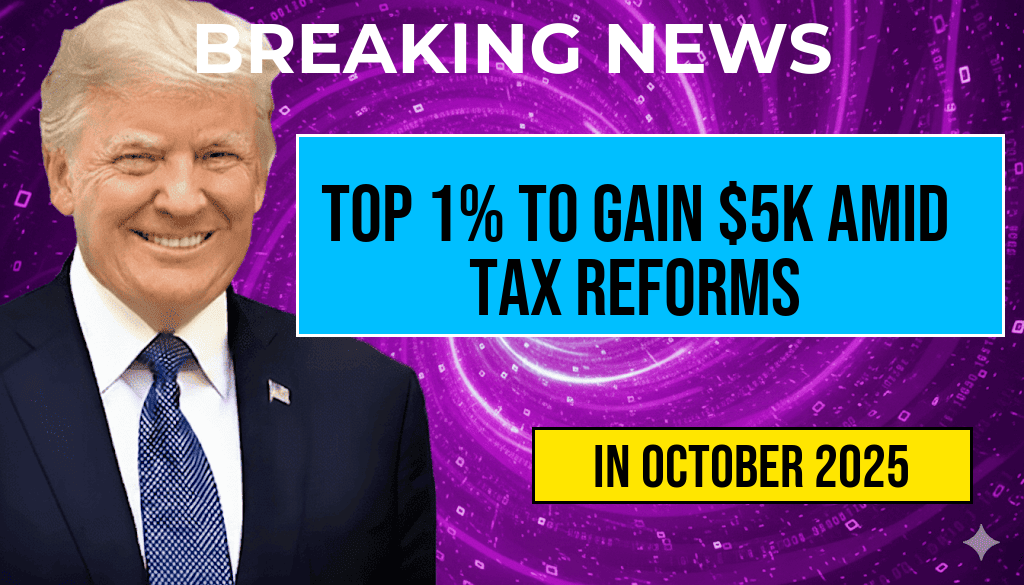The nation’s wealthiest Americans in the top 1% are poised to see an average increase of approximately $5,000 in their annual net income, following recent changes to federal tax reforms. This shift stems from adjustments in tax policies aimed at balancing revenue collection and providing targeted relief, which disproportionately benefit high-income households. While the specifics of the reforms have sparked debate over fiscal equity, analysts highlight that these changes are expected to bolster the financial standing of America’s most affluent, further widening the income gap. Experts emphasize that this development underscores ongoing debates about tax fairness, economic growth, and the distribution of wealth in the United States.
Context of the Tax Reforms and Their Impact
The recent tax reforms, enacted through legislative adjustments made earlier this year, seek to refine the existing tax code. Key measures include modifications to capital gains taxes, estate taxes, and income brackets, all designed to stimulate investment and economic activity. According to the Tax Policy Center, these reforms are projected to generate a net positive effect on high-income earners by reducing their overall tax liabilities.
Specific changes that influence the top 1% include:
- Lowering marginal tax rates on high-income brackets.
- Expanding thresholds for capital gains and dividends taxed at lower rates.
- Adjusting estate tax exemptions, allowing ultra-wealthy families to transfer more wealth tax-free.
Estimating the Net Income Gains
| Income Bracket | Average Net Income Increase | Key Policy Factors |
|---|---|---|
| $5 million and above | $5,200 | Lower capital gains tax, estate exemption increases |
| $1 million – $5 million | $4,300 | Marginal rate reductions, dividend tax adjustments |
| $750,000 – $1 million | $3,800 | Phase-in of new brackets, deductions |
Source: Based on recent analyses from the Forbes and Congressional Budget Office reports.
Economic Implications and Broader Debates
Proponents argue that these tax adjustments incentivize investment among the wealthy, potentially leading to broader economic growth and job creation. “Reducing taxes on capital gains and estate transfers encourages wealth preservation and entrepreneurship,” a Treasury Department spokesperson stated. However, critics contend that the benefits are unevenly distributed and may exacerbate income inequality. Democratic lawmakers have voiced concerns that the reforms favor the wealthiest, neglecting measures that could assist middle- and lower-income families.
Wealth Concentration and Policy Discourse
Data from the Washington Post indicates that the top 1% now controls a significant share of the nation’s wealth, fueling ongoing discussions about fair taxation. Economists warn that without targeted redistribution or increased investment in public services, these gains could contribute to a more pronounced wealth gap.
Potential Long-Term Effects
While immediate net income increases are clear for the highest earners, the long-term impacts of these reforms remain subject to debate. Some analysts suggest that sustained tax advantages could lead to greater capital accumulation among the wealthy, while others argue it risks underfunding essential government programs. The Congressional Budget Office estimates that the reforms could reduce federal revenue by hundreds of billions over the next decade, raising questions about fiscal sustainability and deficit management.
Public Reception and Future Outlook
Public opinion remains divided, with polls indicating that many Americans perceive these reforms as skewed toward the wealthy. Advocacy groups and labor unions continue to press for reforms that ensure a fairer sharing of tax burdens. Meanwhile, policymakers are closely monitoring economic indicators and revenue data to assess the reforms’ effectiveness.
As the debate unfolds, the financial fortunes of America’s elite are likely to continue shifting, influenced by both legislative decisions and broader economic trends. The increased net income for the top 1% exemplifies how policy changes can have tangible effects on individual wealth, prompting ongoing discussions about the balance between economic growth and social equity.
Frequently Asked Questions
Who are the wealthiest Americans expected to benefit from the tax reforms?
The wealthiest Americans in the top 1% are projected to see an average increase of $5,000 in net income due to recent tax reforms.
How will the tax reforms impact the top 1% earners financially?
The tax reforms are designed to provide additional financial gains for the top 1%, resulting in an average net income increase of $5,000.
What factors contribute to the income increase among the wealthiest Americans?
The income increase is primarily driven by changes in tax policies that favor high-net-worth individuals, along with adjustments in investment income and deductions.
Will the tax reforms affect the middle class or lower-income groups?
The tax reforms mainly aim to benefit the wealthiest, and their direct impact on the middle class or lower-income groups may be limited or indirect.
When will the financial benefits of the tax reforms be realized by the top 1%?
The financial benefits are expected to be realized in the upcoming fiscal year, as the tax reforms are implemented and take effect.








